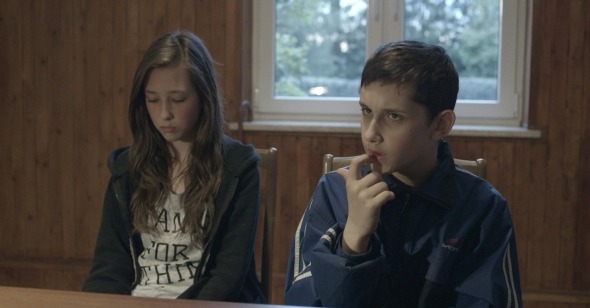Wages of Sin
Caroline Madden on Communion
Communion played Saturday, January 6, 2018, as part of Museum of the Moving Image’s First Look 2018.
Communion opens with a medium shot of a young man’s laborious struggle to put his belt through the loop of his pants. “Wrong, wrong, wrong,” Nikodem (Nikodem Kaczanowski) says, chastising himself as he twists it backwards and fumbles with its clasp. Writer and director Anna Zamecka lingers on Nikodem’s strain to the point of discomfort, visually embodying the simmering pain and frustrations that embroil him and his family. Shot in Poland for 35 days over the course of a year, Zamecka’s debut feature unfolds in a measured and unvarnished style that reflects her anthropologist’s eye. She originally wanted to make a short fiction film based on her childhood—“It had to be fiction,” Zamecka explains, “because I didn’t know how to begin to look for real people that had this similar situation’—but after serendipitously meeting the Kacanowski family she decided to document their lives instead. Communion concerns the devastating and ironic contradictions of 14-year-old girl Ola (Ola Kacanowski) tasked with nursing her autistic younger brother, Nikodem, and alcoholic father, Marek (Marek Kacanowski). Nikodem’s impending communion ceremony serves as the narrative fulcrum, an event that Ola hopes will reunite her with her absent mother, Magda (Magda Kacanowski).
Ola occupies the vacancy left by Magda, tending to Nikodem and Marek with a resolute and tenacious spirit. She reminds her father not to drink, cooks his meals, cleans the home, keeps his appointments, and assists him in writing a letter to their landlord. But it is her relationship with the obstreperous Nikodem that puts her fortitude to the test. The simplest tasks—tying his shoes, giving him a bath, or quizzing him on Scripture—are made all the more difficult by his disability, which leaves him distracted and jittery. Nikdoem even self-identifies with the kinetic energy of animals, frequently pretending to be a lion.
Every so often the pressures of Ola’s domestic role boil to the surface; at one point, after she must repair a broken cabinet door, she shouts, “I’ve had enough—is nothing normal in this place?” The muted colors, mismatched vintage wallpaper, and threadbare furnishings of Ola’s home reflect her aberrant lifestyle and the fractured nature of her family. Zamecka juxtaposes these immuring, tattered interiors with the brightness and vitality of Ola’s social life: the idyllic woods where she plays with friends, or the electronic pulsations and flashing lights of a school dance. These are brief, invigorating respites from the adult responsibilities that encumber her. Aside from some of Ola’s friends, few characters appear outside of her familial orbit. She meets with a social worker, but Zamecka keeps his face off-screen, focusing instead on Ola’s careful replies and minute expressions. The priest who counsels Nikodem is shown only in profile, but we can still sense his exasperation as he tries to wrangle and prepare Nikodem for his sacrament. By obfuscating these adult bodies, Zamecka symbolizes the lack of institutional intervention available to this family.
Communions are momentous and ornate occasions in Polish culture, but Nikodem’s spiritual milestone arrives without much fanfare. Left alone before the ceremony, Ola gingerly fixes her hair with a half-broken brush, then wrestles with the zipper of her fancy yellow-tulle dress. “I feel like a cartoon character!” she cries, suspecting that she is merely costuming herself in the part of a daughter with a functional nuclear family. When Magda eventually returns, Zamecka collapses her long-awaited arrival under the weight of the family’s rigid tension and banality, suggesting that Ola must abandon her naïve self-delusions and acknowledge that the fault lines between her parents are irreparable. The reunited family remains mostly silent during the post-communion dinner, wolfing down their food. Ola scrounges for every second she can have that day with her mom, who makes discreet phone calls to her new partner to barter for more time with her children. There are indications that this other man is abusive, but Zamecka shrouds the adults’ personal details and history in mystery, perhaps to reflect the children’s unawareness. Ola’s wish comes true when her mother decides to move back in, but then she is saddled with caring for her infant half-sibling and mediating her parents’ fierce bickering. Thus, the tiny apartment seems more claustrophobic than ever, with bodies constantly crowding the film’s frame.
The sacrament of communion is meant to foster one’s independent relationship with God, but it is the earthly relationships that are at stake in Communion. In regards to Ola’s mother, one of the social workers tells her, “There are two of you—it is a mutual relationship,” but that is hardly the case. The lack of reciprocity in the adult/child relationships in Communion is disquieting; because of her absent parents, Ola endures hardships that no child should have to bear. Holy Communion also symbolizes a child’s entry into adulthood because they confront the idea that they are born with sin, but Ola and Nikodem’s innocence has long been lost, and they are the ones who must pay for the adults’ sins. Although the siblings’ parents care for them, they cannot see past their own problems. In her captivating and unsettling portrait of lost youth, Zamecka follows her destitute subjects with a patient and intimate observational style, imbuing the narrative with a palpable tension and touching upon her film’s many emotional notes with a quiet grace.
